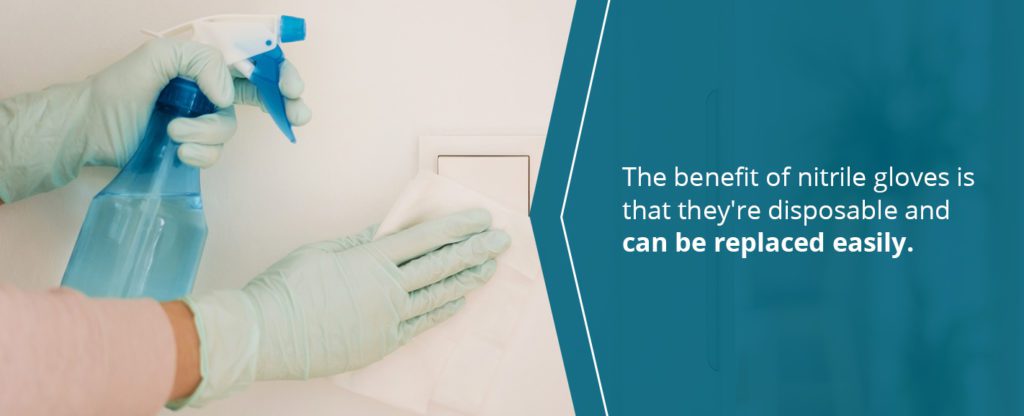
Guide to Wearing Nitrile Gloves
To prevent the spread of germs, nitrile gloves are a top choice for many industries. People can use nitrile gloves in commercial kitchens, laboratories, doctors’ offices, manufacturing warehouses and everyday life to protect against contamination. This type of personal protective equipment (PPE) is made from synthetic rubber that’s flexible, durable and less likely to cause allergic reactions than other disposable glove materials.
This guide will help you choose the right variety of nitrile gloves from SUNLINE Supply and learn the best practices for wearing nitrile gloves for ideal comfort and protection.
Select the Right Type of Nitrile Gloves
These gloves are available in a wide variety to serve a multitude of purposes. Choosing the best option to meet your needs will depend on the task and the desired level of protection and sterilization.
Here are the most common variations of nitrile gloves to help you make the right decision:
- Sterile: Sterile nitrile gloves are specially treated to eliminate all germs and microbes. They’re often used in the medical field for surgeries and other procedures where the risk of infection is high. These gloves are individually packed and must meet high-quality standards, so they tend to cost more than other varieties.
- Non-sterile: Non-sterile nitrile gloves prevent germs from spreading from one person to another. Although they’re not entirely sterile, they’re still useful in many industries. They tend to be more affordable for tasks that require protection rather than complete sterilization.
- Thickness: Nitrile gloves come in a variety of thicknesses or gauges. Thicker gloves offer the maximum level of protection, while thinner varieties provide optimal flexibility for the wearer. Thick gloves are best for handling dangerous chemicals for car repairs, lab tests or cleaning. Tattoo artists and chefs prefer thin nitrile gloves so they can grasp their tools easily.
- Texture: For tasks that require a solid grip, choose textured gloves. They feature a raised design on the palm and fingertips to help you grasp items even in wet and slippery conditions. Textured gloves are ideal in the maintenance industry for mechanics, plumbers and janitors working with their hands.
- Size and color: Simple features like size and color are significant, as properly sized gloves promote comfort and efficiency to make working easier. You can utilize different colors for various tasks to prevent cross-contamination, too. For example, black gloves hide dirt and stains that will stand out on brightly colored options.
How to Put on Nitrile Gloves
It’s important to wear medical gloves correctly to prevent tearing and maximize your defense against germs and hazardous chemicals.
Follow these steps to put on nitrile gloves properly:
- Wash your hands: To promote sanitation and prevent the spread of germs, it’s best to wash your hands thoroughly before touching your gloves. If your glove rips by accident, it’ll help to have a clean hand underneath to prevent infections. Scrub your hands for at least 20 seconds with soap and water and dry them thoroughly before putting on your gloves.
- Slide on the first glove: Starting with your non-dominant hand, lift the glove by the bottom edge and carefully slide your hand inside. Try not to touch the outside of the glove as much as possible. Wait until the second glove is on before adjusting the fit around your hand.
- Slide on the second glove: Repeat the same process to slide the second glove onto your other hand.
- Adjust and look for holes: Once both gloves are on, you can use both hands to adjust the positioning so they’re comfortable and snug. Check both gloves to make sure there are no holes. If you notice a rip, remove the gloves and repeat the process with another pair.
Can You Wear Nitrile Gloves All Day?
While nitrile gloves are durable and puncture-resistant, they’re the most efficient over short periods — wearing the same nitrile gloves all day can decrease their usefulness. The benefit of nitrile gloves is that they’re disposable and can be replaced easily.

Knowing when to change gloves will depend on how you use them. If you handle corrosive chemicals or sharp tools, your gloves may need to be replaced more often. It’s best to get into the habit of replacing nitrile gloves after each task. Once you’ve left the grocery store, finished injecting a vaccine or completed changing a halogen headlight, you can remove your gloves and replace them with a new pair as needed.
Dealing With Sweaty Hands Wearing Nitrile Gloves
These gloves cover your entire hand to minimize cross-contamination and keep your environment sanitary. This fit provides essential protection, but it can also trap heat inside and cause your hands to perspire. Wearing nitrile gloves all day with sweaty hands can cause discomfort and irritate your skin.
Luckily, there are a few tips for wearing nitrile gloves that can help keep your hands dry and comfortable throughout the day:
- Glove changes: Replacing your gloves frequently will prevent sweat from building up inside. Waiting a few minutes before putting on another pair will give your hands a chance to dry out.
- Glove liners: Fabric glove liners create a barrier between the nitrile glove and the skin to reduce sweat.
- Ointments: Protective lotions and creams can prevent your hands from becoming irritated by moist gloves. Medicated versions are available for more serious skin conditions.
- Powdered gloves: Gloves with powder can absorb excess moisture to keep your hands dry.
How to Take Off Nitrile Gloves
If you wear your gloves to handle toxic chemicals or infectious fluids, it is crucial to remove them carefully to prevent contaminants from touching your skin.
This short process is simple but essential:
- Peel off the first glove: Starting with your dominant hand, pinch the glove near the bottom of your wrist and carefully peel it off of your hand. Once it is completely removed, hold the used glove in your remaining gloved hand.
- Peel off the second glove: Using your exposed hand, hook your finger under the second glove and slide it off carefully, tucking the other used glove inside. Avoid touching the outside of the gloves.
- Throw the gloves away: Properly dispose of the contaminated gloves.
- Wash your hands: Thoroughly wash your hands afterward to sanitize your skin.
Shop Nitrile Gloves in Bulk at SUNLINE Supply
SUNLINE Supply offers a wide range of nitrile gloves suitable for many different industries. Our products are available in bulk to supply your entire operation with PPE at an affordable price. We are a company that only carries the top quality products from vendors. You can rely on our nitrile gloves to protect your hands from dangerous substances and prevent the spread of germs.
Browse our range of nitrile gloves and place an order today.


